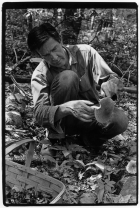
|
ROARATORIO "Roaratorio: An Irish Circus on Finnegans Wake" (1979) is a 60-minute radio piece based on James Joyce's book Finnegans Wake. At its core is John Cage's text "Writing for the Second Time Through Finnegans Wake," a series of mesostics that form an objective reduction of Joyce's overwhelming text. "Roaratorio" consists of four "layers" of sounds. First is the voice of Cage himself speak-singing his text, thus providing a space-time line. Second is a collection of field recordings from the places mentioned in the book (626 locations). Third is a collection of sounds mentioned in the book. Finally, Cage recorded Irish musicians (Joyce was Irish) and added their pieces to the mix, for a total of 62 tracks of constantly shifting sonic magma that live a dizzying life, just like Joyce's novel. Even though Cage used chance operations to make editing and mixing choices, the piece doesn't have the gratuitous or aleatory feel of some of his other hörspiels and is simply a fascinating (although highly complex) work. (François Couture - All Music Guide AMG). |
Using the IC program, Cage determined 2293 sounds depiciting locations and noises that appear in Finnegans Wake, all recorded at the places mentioned in the book. There are 15 categories of sounds: Thunderclaps, thunder rumbles and earthquake sounds - Laughing and crying (laughtears) - Loud voice sounds (shouts, etc.) - Farts - Musical instruments (short) - Bells, clocks, chimes - Guns, explosions - Wails - Animals and particular birds - Music (instrumental and singing) - Water - Birds (in general) - Singing - Places. 1 Some excerpts : If you can't access to the players above, click here |
|
MUSICIRCUS A Musicircus may be described as "an environmental extravaganza, where many unexpected events occur within a delimited space" (Kostelanetz 171). John Cage mounted such productions at the University of Illinois in 1967 and 1969. They featured randomly spaced, and overlapping performances of his and other composers' compositions, projections, artworks etc. The audience was free to roam through the space, entering and leaving at will. 2 "I have not made detailed directions for Musicircus. You simply bring together under one roof as much music (as many musical groups and soloists) as practical under the circumstances. It should last longer than ordinary concerts, starting at 7 or 8 in the evening, and continuing, say, to midnight. Arrange performers on platforms or within roped-off areas. There must be plenty of space for the audience to walk around. If you have more groups than places, make a schedule: Group 1 in Place A from 7-9:30; Group 23 in Place A from 9:45-midnight. Etc. There should be food on sale and drinks (as at a circus). Dancers and acrobats." (John Cage, letter dated June 6, 1973) "One very important element is that there should at all times be many people performing simultaneously. The next is that, since none of the musicians are being paid, there being too many of them, the entire event must be free to the public. ... In harmony with the separation of this work from conventional economics, I have not made a score nor have I published one of course." (John Cage, letter dated December 23, 1979) |
A DIP IN THE LAKE: Ten Quicksteps, Sixty-two Waltzes, and Fifty-six Marches for Chicago and Vicinity (1978) 3 for performer(s) or listener(s) or record maker(s) The concept of this work is to go to the places (in Chicago or any other city, by assembling a chance determined list of 427 addresses, grouping them in 10 groups of 2, 61 groups of 3 and 56 groups of 4) and either listen to, perform at and/or make a recording of the sounds at those locations. (www.johncage.info) Dip in the Lake is the exploration of a city by means of a 'random' soundmap that leads 'performers, listeners, or record makers' to places they may never have been before. The published score consists of a list of 427 locations divided into 10 groups of 2 (Quicksteps), 61 groups of 3 (Waltzes) and 56 groups of 4 (Marches). The mental image evoked by the composition is a summer band concert by the lake, with a brass band playing a selection of short instrumental pieces for the amusement of the crowd. Record makers or performers wishing to undertake a realization of the piece, are instructed to attend at the locations specified in the score and make audio recordings of what they encounter. These may be random sound events or involve a performance of some sort. (Bill Blakeney) |